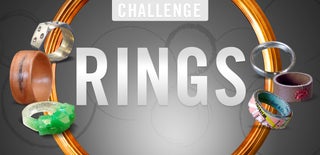Introduction: 3D Printed Socket Wrench Ring
More function than fashion... the SocketRing is a great addition to any toolbox and was created to help get to those nuts and bolts in tight places where a standard socket wrench just won't fit. The current version accepts any 3/8-inch drive socket and the specially designed tabs provide a friction fit that keeps the socket from falling off.
Step 1: Determine Your Ring Size
The socket wrench ring can be worn on any finger but it works best for tightening and loosening when worn on the index finger, in the location shown in the images. To determine your ring size, measure the circumference of your finger using the following steps:
- Wrap a piece of string, ribbon, or paper around your finger where you want the ring to sit.
- Make marks on both ends of your string (or whatever else you used) at the point where the two ends cross.
- Measure the distance between the two marks.
After you have your circumference measurement, consult a ring sizing chart to determine the corresponding ring size. A good ring sizing chart is available from Wikipedia here.
Step 2: 3D Print the Ring
Currently there are four versions of the 3/8" drive SocketRing available in U.S. ring sizes 6, 8, 10, and 12. If you have your own 3D printer, the STL files are available for download using the links provided in these instructions.
It's recommended that your printer settings are adjusted so that the ring prints as a completely solid part (100% infill) for maximum strength. The ring is designed to print without using any support material as long as it is oriented correctly (correct orientation is shown in the photo). The example ring in the photo was printed in ABS plastic, but other plastics such as PLA and nylon should work fine as well. If the material is too brittle, there is a chance that the flexible tabs could snap off.
Also, if you don't want dirt and grease to mark up the surface of the ring, print in a dark color :-)
Attachments
Step 3: Attach a Socket and Start Wrenching!
Grab a socket and push it onto the ring. The tabs on the ring are designed to provide a snug fit that will keep the socket from falling off. There should be a little resistance but not too much. If you find that it is too hard to push the socket on, use a very fine grit sandpaper or emery cloth and lightly sand any rough spots on the tabs.
The easiest way to use the ring is to place it on your index finger as shown in the photos. Grip the ring and use the same turning motion that you would use if you were unlocking (or locking) a door with a key.
Please post your comments and let me know what you think. Also, let me know if you have any ideas for improving the design. If you've printed one, I would love to hear your about your experience using it (good or bad).

Participated in the
Small Spaces Contest

Participated in the
Rings Challenge

Participated in the
Tools Contest













